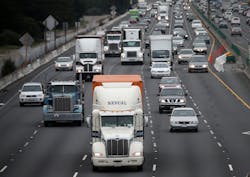AAA: Truck safety technology can prevent 63,000 crashes a year
Equipping large trucks with advanced safety technologies has the potential to prevent up to 63,000 truck related crashes each year, according to new research from the AAA Foundation for Traffic Safety.
In 2015, large trucks were involved in more than 400,000 crashes that resulted in more than 4,000 deaths and 116,000 injuries – a 4% increase from 2014. AAA recommends that all large trucks, both existing and new, get equipped with technologies that improve safety for everyone on the road.
“There’s no question that truck safety technology saves lives,” David Yang, executive director of the AAA Foundation for Traffic Safety, said. “This new research shows that the benefits of adding many of these technologies to trucks clearly outweigh the cost.”
The report, Leveraging Large Truck Technology and Engineering to Realize Safety Gains, examined the safety benefits and costs of installing four advanced safety technologies in both existing and new large trucks: lane departure warning systems, automatic emergency braking, air disc brakes, and video-based onboard safety monitoring systems. Researchers found that:
The societal safety benefits (i.e., economic value of lives saved and injuries prevented) of equipping all new and existing large trucks with lane departure warning and video-based onboard safety monitoring systems far outweigh the costs:
- Lane departure warning systems can prevent up to 6,372 crashes, 1,342 injuries and 115 deaths each year.
- Video-based onboard safety monitoring systems can prevent as many as 63,000 crashes, 17,733 injuries and 293 deaths each year.
The societal safety benefits of equipping all new trucks with automatic braking or air disc brakes could outweigh costs:
- Automatic emergency braking can prevent up to 5,294 crashes, 2,753 injuries and 55 deaths each year.
- Air disc brakes can prevent up to 2,411 crashes, 1,447 injuries and 37 deaths each year.
Public weighs in
A recent AAA survey conducted in parallel with the AAA Foundation’s research found that six out of 10 (61%) U.S. adults feel less safe driving past large commercial trucks than driving past passenger cars. The top three reasons are:
1. Trucks’ large size and length (28%)
2. Trucks have greater blind spots/less visibility (18%)
3. Trucks can drift or swerve out of their lane (14 %)
About one in four (26 %) U.S. adults say adding safety technology to large trucks would help them feel better about sharing the road.
“It’s understandable that many motorists are fearful and feel vulnerable when traveling near large trucks,” said Jake Nelson, AAA director of Traffic Safety Advocacy and Research. “Adding these safety technologies to the trucking fleet is not only cost effective, but doing so helps to alleviate driver concerns and prevents crashes. In the long run, it’s a win-win for industry and drivers nationwide.”
Professional truck drivers and motorists have a mutual responsibility to safely share the road by being attentive to changing road factors and driving conditions. When traveling near a large truck, drivers should:
- Be aware that trucks have large blind spots or “no-zones.” As a rule of thumb, if you cannot see the driver in the truck’s side view mirror, they cannot see you.
- Leave plenty of room between your vehicle and a truck when coming to a stop on a hill. Trucks may roll back as the driver takes his or her foot off the brake.
- Avoid speeding up when a truck is passing. Slow down and give the truck driver plenty of room to pass.
- Follow trucks at a safe distance.
- Allow plenty of space for a truck driver who is signaling to change lanes.
About the Author
Fleet Owner Staff
Our Editorial Team
Kevin Jones, Editorial Director, Commercial Vehicle Group
Cristina Commendatore, Executive Editor
Scott Achelpohl, Managing Editor
Josh Fisher, Senior Editor
Catharine Conway, Digital Editor
Eric Van Egeren, Art Director
